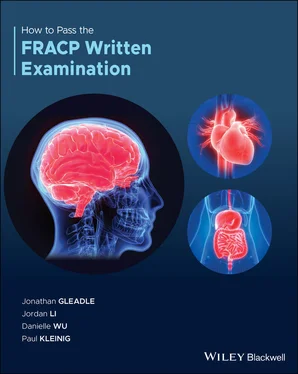Meningococcal septicaemia is characterised by rash, which is typically maculo‐papular and blanching when seen very early in the disease course, and remains blanching in 10 to 15% of cases, and 5 to 10% of patients do not develop rash. However, around 70% of patients have the typical, non‐blanching rash, which is either petechial or purpuric, on presentation to hospital. Given the severe nature of invasive meningococcal disease, other symptoms and signs need to be taken into account in presumptive diagnosis – the rash is not sensitive enough.
Necrotising fasciitis is a severe subcutaneous infection that requires surgical debridement in addition to antibiotics. Early diagnosis has positive impact on outcome, and typically, early infection resembles severe cellulitis except for severe tenderness, severe sepsis, and rapidly progressive rash, signs which should prompt a high index of suspicion for the disease. Type I necrotising fasciitis is typically polymicrobial with both aerobic and anaerobic bacteria, whereas type II is monomicrobial, and usually caused by Group A Streptococcus .
Disseminated candidiasis with skin lesions is a rare complication of profound immune suppression, most commonly neutropaenic patients with acute myeloid leukaemia during induction therapy. Diffuse maculopapular lesions predominate in cases caused by Candida tropicalis, and nodular or papular lesions in cases caused by Candida krusei .

Vashi N. The Dermatology Handbook. Cham: Springer International Publishing; 2019.
https://link.springer.com/chapter/10.1007/978-3-030-15157-7_5
4 Endocrinology
Questions
Answers can be found in the Endocrinology Answers section at the end of this chapter.
1 1. A 48‐year‐old woman is referred by her GP with a 3‐month history of headaches and night sweats for investigation. Her medical history includes difficult to control hypertension for 5 years which requires 3 agents; OSA on CPAP treatment, glucose intolerance, and total hysterectomy 7 years ago. On examination, BP is 156/95 mmHg, her hands are large, and she is no longer able to wear her ring. There is no hirsutism buts there is coarseness of her facial features. Her laboratory test results and MRI of head are shown below.TestsResultsNormal valuesHbA1c6.5%<6.0%Cortisol (9 am)320 nmol/L133–540Free T415 pmol/L10–20Prolactin278 mIU/L90–630Estradiol48 pg/ml15–350Growth hormone (GH)362 pmol/L<226Insulin like growth factor 1 (IGF‐1)748 ng/ml<320What is the most appropriate next step for this patient? Inferior petrosal sinus sampling for growth hormone.Measurement of growth hormone after insulin induced hypoglycaemia.Measurement of growth hormone releasing hormone (GHRH).Referral to neurosurgery.
2 2. A 28‐year‐old woman presents to the emergency department with symptoms of nausea, vomiting, diarrhoea, severe lethargy, weakness, and drowsiness. Her BP is 85/45 mmHg, heart rate is 98 bpm, respiratory rate is 13/min, blood glucose level is 5.6 mmol/L [3.2–5.5 fasting], and temperature is 38°C. Her serum sodium level is 130 mmol/L [135–145] and potassium level is 5.8 mmol/L [3.5–5.2]. You find a MedicAlert necklace which says, ‘Adrenal insufficiency’.Which one of the following steps of management is INCORRECT?Administer IV hydrocortisone 100 mg stat followed by IV hydrocortisone 50 mg qid.Administer IV 0.9% normal saline 1 L within the first hour.Avoid giving corticosteroid due to the potential risks of worsening sepsis.Perform a septic screen and start empirical broad‐spectrum antibiotics.
3 3. A 65‐year‐old woman was referred by her GP to the general medicine clinic with a 2.5 cm adrenal mass during investigation for abdominal discomfort. She reports no symptoms of headache, sweating, palpitations, significant weight changes, night sweats, fever, nausea, vomiting or proximal muscle weakness. She has a history of hypertension, type 2 diabetes, obesity, and osteoporosis.Which one of the following investigations is NOT indicated at this stage?24‐hr urinary fractionated metanephrine and catecholamine collection.Overnight dexamethasone (1 mg) suppression test.Plasma aldosterone and plasma renin activity measurement.Positron‐emission tomography (PET) scan.
4 4. A 65‐year‐old man is referred to the endocrine clinic with a 6‐week history of unintentional weight loss (5 kg), diarrhoea, myopathy and lethargy. He has a history of atrial fibrillation, diagnosed one year previously. He was started on amiodarone and warfarin but he reverted to sinus rhythm spontaneously at which point the amiodarone was stopped 6 months prior to presentation. On examination, there is no obvious goitre. He has an irregularly irregular pulse at 90 bpm. His skin is warm and sweaty. His TSH level is 0.2 mIU/L [0.4–4.0], Free T4 level 30 pmol/L [9.0–25.0], and Free T3 10–pmol/L [3.5–7.8].Which one of the following management strategies is correct?Commence carbimazole.Commence high‐dose oral prednisolone.Commence carbimazole and high‐dose oral prednisolone.Referral for thyroidectomy.
5 5. A 23‐year‐old woman presents to hospital because of a 3‐day history of confusion, cough, white sputum and fever. She is diagnosed with a lower respiratory tract infection and commenced on intravenous penicillin and normal saline infusion. She was diagnosed with type 1 diabetes at age 6. She is currently receiving short acting insulin three times a day before meals and insulin glargine at night. She has had several hypoglycaemic episodes recently. She has been intermittently taking thyroxine 100 mcg daily for 5 years after being diagnosed with hypothyroidism. She has not been feeling well in the past 4 months, experiencing fatigue, nausea, poor appetite, and weight loss of approximately 7 kg. On examination, she is afebrile, BP is 85/50 mmHg and HR is 110 bpm, the rest of her physical examination is unremarkable. The initial investigation results are shown below.TestsResultsNormal valuesSodium128 mmol/L135–145Potassium5.5 mmol/L3.5–5.2Bicarbonate24 mmol/L22–32Urea28 mmol/L2.7–8.0Creatinine123 μmol/L45–90Glucose16.3 mmol/L3.2–5.5Calcium2.95 mmol/L2.1–2.6Hb140 g/L115–155WBC7.1 x109/L4–11CRP7 mg/L0–8HbA1c8.6%<6%What is the most appropriate immediate next treatment?Commence insulin infusion.Give double dose of thyroxine immediately.Give intravenous norepinephrine.Intravenous hydrocortisone.
6 6. Which one of the following is a characteristic of brown adipocytes?Adiponectin secretion.Leptin secretion.Storage of energy‐yielding triglycerides.Uncoupling protein 1–containing mitochondria.
7 7. A 37‐year‐old woman is referred by her GP following a low energy fracture to her right distal radius. She is a current heavy smoker. She is diagnosed to have osteoporosis with bone mineral density Z score of –2.8 in the lumbar spine. She is obese with BMI 33 kg/m2. BP is 150/95 mmHg. She has facial rubor and proximal muscle weakness. Her 24‐hour urine free cortisol excretion is 55 μg [3.5–45]. Baseline serum 8 a.m. cortisol level is 320 μg/L [70–280] and is 310 μg/L the following morning after taking 1 mg dexamethasone. The baseline plasma level of adrenocorticotropic hormone (ACTH) is 8 pg/ml [10–90].Where is the most likely anatomical location of her clinical presentations?Adrenal cortex.Hypothalamus.Lung.Pituitary gland.
8 8. While treating a patient with stage 2 CKD due to diabetic nephropathy (DN) with significant proteinuria and hypertension, which one of the recommendations is appropriate?ACE inhibitor has better renoprotective effects in patients with DN than angiotensin II receptor blocker (ARB) and the renoprotective effect of ACE inhibitor is dose‐related.Dual Renin‐Angiotensin‐Aldosterone System (RAAS) blockade with both ACE inhibitor and ARB should be prescribed as it has better antiproteinuric effect compared to monotherapy.Intensive glycaemic control in patients with type 2 diabetes reduces incidence and progression of DN and all‐cause mortality.Intensive glycaemic control reduces progression of DN in type 1 diabetes; this benefit persists even after the patient returns to suboptimal glycaemic control.
Читать дальше













